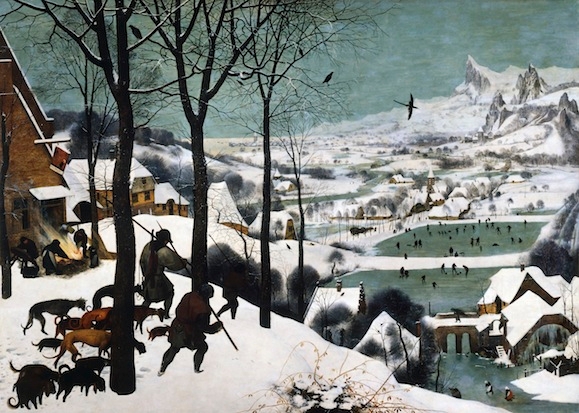The ostensible subject matter is misleading, as is any conflation with his lesser relatives’ wassailing peasants and roistering village squares. But Pieter Bruegel the Elder’s work is profoundly serious. It has a formidable intellectual content, a Shakespearian emotional range: a sardonic and stoical view of the human condition. There are paintings — ‘The Triumph of Death’, ‘The Blind Leading the Blind’ — which descend from Hieronymus Bosch. There is also the marvellous ‘Fall of Icarus’. According to recent scholarship, the version we have is not a Bruegel, but a later copy. That is plausible; it looks later. Yet the composition is classic Bruegel. He would be drawn to any legend expressing the vanity of human wishes.
Bruegel’s world is Hobbesian. But Hobbes was a eupeptic pessimist. One suspects that this was also true of Bruegel. Endure, and enjoy. That applies most obviously in his winter scenes, and especially ‘Hunters in the Snow’, one of my favourite paintings. I do not think that any other artist is as good at making you feel cold. Cresting a hill, the returning hunters look miserable, as do their hounds, who might well be regretting their ancestor’s decision to accept that caveman’s hunk of rancid mammoth fat, thus sealing the great concordat between man and dog at the beginning of history and laying one of the foundations of civilisation. ‘In elevating mankind, Dog played a lesser role than God, but still a crucial one’: discuss.
As for the owners: they look frozen, chilled-to-the-marrow frozen, all-sensitive-parts-turned-to-icicles frozen. They appear to have caught one rabbit. Will that be enough to replace the calories which the cold has consumed? One’s eye is caught by the crows aloft, no doubt assessing the carrion potential of the groundlings below.
Yet they may be crowing too soon. Down in the valley, on the ice-bound ponds, sliding and slithering and revelling, the well-wrapped-up villagers are having fun. Though these tough Flemings may not aspire to soar like Icarus, they will defy the cold, as they so often defy their rulers. Life goes on.
We were discussing all this in the Hispania restaurant, on an evening as cold as London gets, over a glass and a dish. The glass was a white spirit, Orujo bianco, which tasted like a cross between grappa and poteen. The dish was black lentils with chorizo, spiked up by wine vinegar: a wonderfully hearty flavour. Between them, they would have revived the coldest hunter in Europe. Emergency supplies ought to be rushed to the Somerset Levels.
This was winter fare, designed for the era before central heating, of thick pullovers, hot-water bottles, even vests. Hispania provides a range of other excellences, including glorious Spanish jamon: glistening, subtle but potent, piggy. There were also the best anchovies I have eaten, which went magnificently with a Gonzalez Byass fino, una palma: a three-rosette combination if ever I one. We moved to red wines, mainly young, drinking well but with more to come, all of which exemplified the strides that Spanish viniculture is making. If I could make sense of my tasting notes, I might go into more detail — but if you are feeling like an excursion into Spanish wine, pull on your drinking boots and go to Hispania.
Apropos of young reds, my friend Jaspar Corbett of Compass wines has a few cases of upper-end Rossignol-Trapet from 2009 and 2010. This is a relatively new domaine, created by a dynastic marriage between established Burgundians, blending science and tradition. I think that the results are extremely promising. More to the point, Berry Bros concur. Jaspar’s bottles need keeping, but will be superb and are, alas, priced accordingly. Rossignol-Trapet is a name to conjure with: truly a beaker full of the warm South. If only Keats’s health had enabled him to enjoy and endure.






Comments